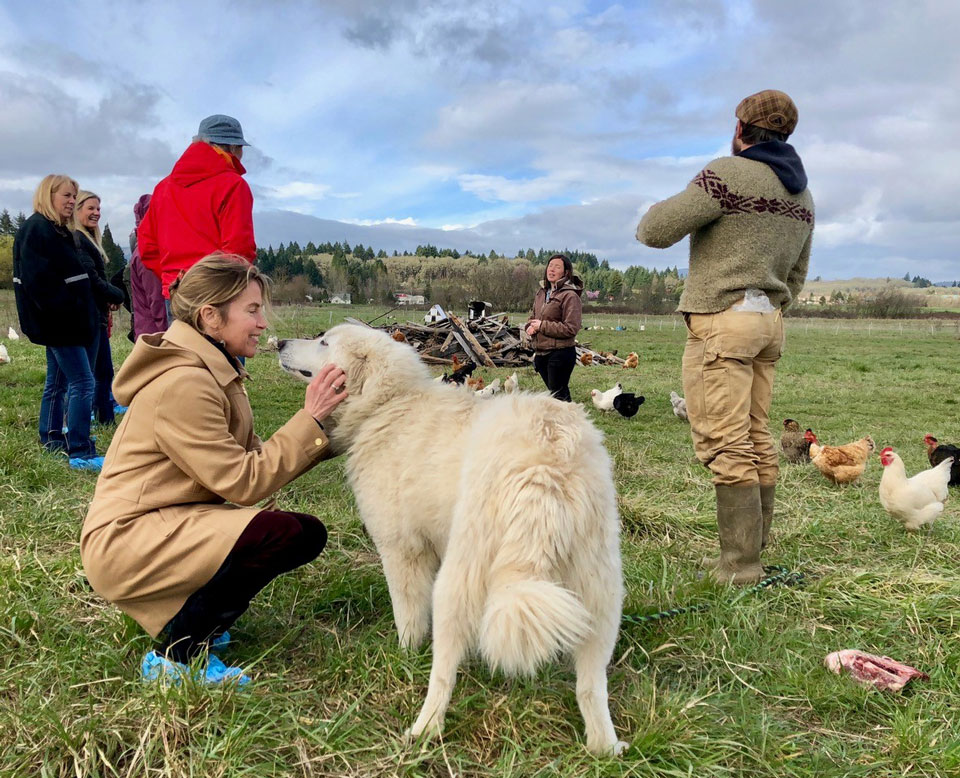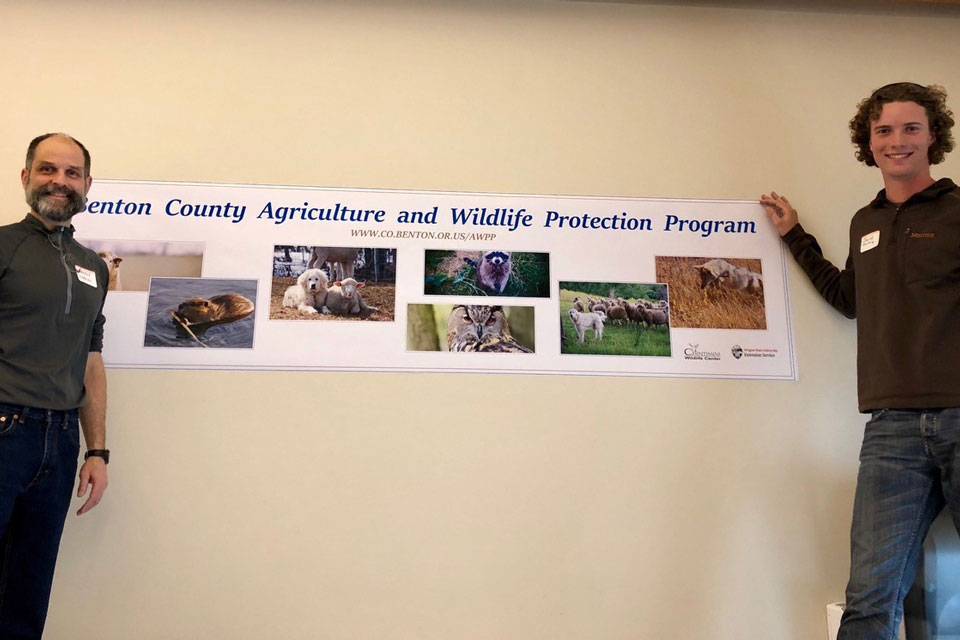Farming with Wildlife ~ An Interview with Randy & Pam Comeleo
Camilla H. Fox
Founder & Executive Director
As Project Coyote works with colleagues and coalitions to reform predator management at federal, state and county levels, we are also building partnerships to advance peaceful coexistence models.
Recently, Benton County, Oregon, adopted an Agriculture and Wildlife Protection Program that supports innovative non-lethal projects aimed at reducing conflicts between livestock and predators. As part of this program, Project Coyote Ranching with Wildlife Coordinator Keli Hendricks and I recently participated in Benton County’s first Farming with Wildlife Workshop. We were thrilled to share our knowledge and expertise on the subject of reducing conflicts between livestock and predators and why predators are essential to healthy ecosystems—and just as thrilled to see the enthusiasm from county officials and residents about this inspired new program. This kind of creativity, forward thinking, and community involvement is exactly what’s needed to promote coexistence models that can be both cost-effective and win-win programs. Such programs require dedicated leadership in order to succeed, and Benton County residents Randy and Pam Comeleo have demonstrated that leadership with tenacity, diplomacy, compassion, and vision. I hope you’ll enjoy this interview with them and feel inspired by their and Benton County’s actions on behalf of both wildlife and agriculture. Read Randy’s recent feature article “Using Coyotes to Protect Livestock: Wait. What?” in the Oregon Small Farm News here.
Keli Hendricks, Camilla Fox, and Randy and Pam Comeleo at the Farming with Wildlife Workshop, Corvallis, Oregon, March 17, 2018
Please share how you became involved with the issue of predator management in Benton County and how predators have historically been managed in the county.
A: We first became involved in February 2012 when neighbors found a live raccoon caught in a USDA Wildlife Services trapper’s snare on an Oregon State University Sheep Research Center perimeter fence. In its desperate struggle to escape, the raccoon had woven its body into the wire fence. Due to the public outcry surrounding this event, the university stopped setting baited snares. However, a year later—after media attention had waned—the university began using snares again.
While reviewing the 240-page Benton County biennial budget in early 2015, we discovered an entry buried on page 220 indicating that our county tax dollars were funding this kind of indiscriminate lethal predator control through a contract with Wildlife Services. At an April 2015 budget hearing, we asked if the county would consider implementing a wildlife-friendly alternative to the lethal animal damage control program operated by USDA APHIS Wildlife Services. The budget committee—which had long complained that Wildlife Services provided no reports evaluating the long-term overall effectiveness or cost-effectiveness of its trapping program—seemed interested in the idea.
To determine the impact of lethal control on wildlife and unprotected livestock, crops, and property, we submitted Freedom of Information Act (FOIA) requests to USDA to obtain ten years of Benton County wildlife take (kill) and damage (livestock, crops, and property) reports. Included in the FOIA documents was a very thought-provoking statistic: from 2004-2014, 456 sheep were killed and the county trapper killed 456 coyotes in response. That these numbers are identical may be coincidental, but because scientific studies have shown that traps and snares often kill non-offending individuals, this statistic begged the question: were Benton County taxpayers simply supporting revenge killing?
During this same ten-year period we also learned that the Benton County lethal control program cost Benton County residents $174,590, while residents sustained $166,406 in agricultural and property losses. Clearly, the use of traps and snares was ineffectual in preventing losses.
Camilla Fox with Livestock Guard Dog on Red Bird Acres Farm Tour (Philomath, OR)
We had heard about Marin County’s Livestock and Wildlife Protection Program and Camilla Fox’s involvement with the program. So we reached out to Project Coyote because we were planning to propose a similar program for Benton County. In July 2015, Camilla Fox gave a presentation about the Marin program to our county commissioners, and Project Coyote has been an important partner in the development of our program ever since.
In December 2015, the Benton County commissioners asked us to prepare a formal proposal for a non-lethal animal damage control program and present it to the county budget committee at the next (2017) biennial budget hearing. We spent the next year (2016) researching non-lethal methods and talking to predation management experts, local farmers, and conservation groups.
To assist in the development of the proposal, we invited former Wildlife Services researcher and author John Shivik (The Predator Paradox) to give a public presentation and a university lecture, and to conduct a non-lethal deterrents workshop and listening session with local ranchers. One year later, in December 2016, we submitted a formal proposal to the budget committee for a Benton County Agriculture and Wildlife Protection Program (AWPP). In June 2017, the budget committee approved $45K for a two-year pilot program to encourage the proactive use of non-lethal animal damage deterrents in an effort to foster the coexistence of agriculture and wildlife in Benton County.
What were the steps involved in creating the program after funding was approved?
A: The first step was to have the county identify an employee who was supportive of the program concept and who would be willing to serve as a liaison between program organizers and county government.
Next, we established a citizen Advisory Committee to work on developing the elements of the program. It was important to find committee members who were interested in both local farming and wildlife and who would be willing to spend a significant amount of their free time researching, writing, and reviewing program documents, promoting the new program, and organizing events.
Third, we partnered with two well-respected local organizations to help establish the new Agriculture and Wildlife Protection Program: the Oregon State University Extension Service Small Farms Program and the Chintimini Wildlife Center. Representatives from each of these key organizations serve on the program’s Advisory Committee.
Finally, we organized a team of experts who agreed to advise our program on ranching with wildlife, predator ecology, and human-carnivore conflict. Four of the six AWPP Program Advisors are Project Coyote representatives or Science Advisory Board members.
The citizen Advisory Committee spent seven months preparing a grant application form and scoring system, a project evaluation form, and promotional materials and articles. The team developed a project website, made a public presentation, and held a conference tabling event and workshop. We promoted the grant program through direct emails to farmers, press releases, social media, and coordination with local farming organizations.
Project Coyote provided key materials from the Marin County Livestock and Wildlife Protection Program and from their Northern California 2016 Ranching with Wildlife Workshop, all of which provided ideas for our AWPP grant application form, promotional materials, and workshop.
How does the program work, who is involved, and what kinds of non-lethal methods will be tested through this program?
A: The Benton County Agriculture and Wildlife Protection Program (AWPP) funds educational outreach, expert consultation services, and a merit-based, cost-share, reimbursement grant program. Agricultural operations in Benton County that wish to prevent conflicts with wildlife may qualify for up to $5,000 in reimbursement grant funds for the purchase of proactive non-lethal wildlife deterrents to protect livestock and crops.
Non-lethal wildlife deterrent equipment, devices, and housing that proactively protect livestock and /or crops are eligible for funding. Examples of non-lethal deterrents include, but are not limited to: guardian animals, certain types of fencing, birthing sheds, night corrals, visual and acoustic scare devices, and methods and devices to protect trees and prevent flooding due to beaver activity.
This new community-based program is funded by Benton County and managed by county officials in partnership with an Advisory Committee comprised of citizen volunteers, and with representatives from Oregon State University Extension Service and Chintimini Wildlife Center.
The goals of the Benton County Agriculture and Wildlife Protection Program are to:
- Invest in farmers who wish to protect livestock and crops while coexisting with wildlife;
- Encourage the proactive use of non-lethal animal damage deterrents to prevent conflicts with wildlife;
- Offer a wildlife-friendly alternative to the county-funded lethal animal damage control program operated by USDA APHIS Wildlife Services; and
- Educate farmers and the community about wildlife, wildlife conflicts and wildlife-friendly methods to avoid conflicts.
The AWPP grant program requires an application for non-lethal wildlife deterrent reimbursement funds. All grant applications are evaluated by the AWPP Committee and reviewed by county officials. Successful applicants are notified of the amount awarded and may then purchase the approved deterrents and submit a reimbursement request form and receipts to the county. A check is then issued for up to the amount awarded in the name of the applicant. Successful applicants are required to maintain project records, report conflicts, evaluate their project, and abide by program restrictions. Grant recipients may not use non-selective lethal wildlife control methods such as traps, snares, calling-and-shooting, denning (killing animals in their burrows or dens), or poisons at the location of the non-lethal deterrents project. Targeted killing (e.g., shooting) of an offending individual wild animal is allowed under the program, but only when the animal is caught in the act of biting, wounding, killing or chasing healthy livestock.
Keli Hendricks, Project Coyote Ranching with Wildlife Coordinator, discusses non-lethal livestock-predator conflict solutions
What kind of training and assistance about non-lethal predator deterrents will be provided to ranchers?
A: The educational outreach program provides educational information in the form of a website, brochures, articles, and occasional public presentations and training workshops on wildlife conflict prevention.
A link to Project Coyote’s Nonlethal Solutions to Reduce Conflicts web page is provided on our program website and the Project Coyote Ranching with Wildlife brochure was co-branded by the county and printed for distribution at program events. Project Coyote’s Camilla Fox and Keli Hendricks gave presentations at our March 2018 Farming with Wildlife Workshop.
Consultation services on the selection and use of non-lethal wildlife deterrents are provided to agricultural operations in Benton County that are anticipating or have experienced conflicts with wildlife. These services are provided by Benton County, Oregon State University Extension Service, Chintimini Wildlife Center, and the Program Advisors described above.
How will the county evaluate efficacy and success of this pilot project, and how will this information be shared with the public?
A: The new program will track individual conflicts and solutions and provide an annual Program Evaluation Report. This information will be used by county officials and the AWPP Committee to evaluate the program and help identify effective methods and projects. We will look for the maintenance of conflict-free non-lethal deterrents project sites or reductions in conflicts at project sites with a history of conflict. We will also look for increasing participation by Benton County farmers over time. Program evaluation documents will be made available to the public on the program website.
What is your hope for this program in Benton County and beyond?
A: Our hope is that most local farmers will find that use of non-lethal deterrents agrees with their farming philosophy and that they tend to be more effective over time than the ongoing use of traps and snares. Benton County Administrator Joe Kerby has said that he hopes that, like the Marin County program, the Benton County Agriculture and Wildlife Protection Program will serve as a model for other counties to follow.
Randy Comeleo and Jakob Shockey, Beaver State Wildlife Solutions at the Farming with Wildlife Workshop, Corvallis, Oregon, March 17, 2018 (sponsored by the Benton County Agriculture and Wildlife Protection Program)








